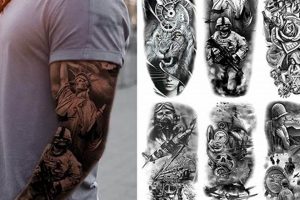A full-arm tattoo, or sleeve, designed around Christian themes represents a significant commitment to expressing faith visually. Such designs often incorporate interconnected elements like biblical figures, verses, symbols, and iconography to create a cohesive narrative. For example, a sleeve might depict scenes from the life of Christ alongside symbolic representations of the Holy Trinity, interspersed with relevant scripture passages.
Permanent body art offers a powerful medium for communicating personal beliefs and values. Within Christianity, tattoos can serve as a constant reminder of faith, a testament to spiritual journeys, and a visual expression of devotion. Historically, while tattooing has held varying levels of acceptance within Christian communities, the practice has seen a resurgence in recent years, particularly among younger generations seeking meaningful and personalized forms of religious expression. This renewed interest has led to a diverse range of artistic styles and interpretations of traditional imagery.
Exploring specific design elements provides further insight into the rich tapestry of concepts suitable for a religious-themed sleeve. Common subjects include depictions of Christ, crosses, angels, doves, and biblical scenes. Additionally, the incorporation of specific verses, hymns, or prayers adds a personalized layer of meaning. The following sections delve deeper into these aspects, offering guidance and inspiration for those considering such a permanent display of faith.
Tips for Christian Tattoo Sleeve Designs
Careful planning is crucial for a cohesive and meaningful Christian-themed tattoo sleeve. These tips offer guidance throughout the design process.
Tip 1: Research Symbolism: Thorough research ensures accurate representation of chosen symbols. A seemingly simple image may hold multiple interpretations, some potentially conflicting with intended meanings. Understanding the historical and theological context of each element prevents unintended misrepresentation.
Tip 2: Consider Placement and Flow: The body’s natural contours influence how a sleeve appears. Plan the arrangement of elements to complement these curves, creating a visually harmonious flow across the entire arm. Consider how the design will look from different angles.
Tip 3: Choose a Reputable Artist: Selecting a skilled and experienced tattoo artist specializing in the desired style is paramount. Review portfolios, seek recommendations, and discuss the design in detail before committing. A skilled artist provides valuable input and executes the vision with precision.
Tip 4: Reflect on Personal Significance: A tattoo sleeve represents a deeply personal statement of faith. Incorporate elements holding specific meaning and resonance, reflecting individual spiritual journeys and beliefs. This personalization imbues the design with authenticity and lasting significance.
Tip 5: Plan for Long-Term Commitment: Tattoo removal is a costly and time-consuming process. Careful consideration of design choices is essential before committing to a permanent alteration. Reflect on the chosen imagery and its long-term relevance to personal faith.
Tip 6: Explore Different Art Styles: Various tattoo styles, from realism to traditional, can effectively convey Christian themes. Researching different styles and discussing options with the chosen artist helps determine the best approach for expressing the desired message.
Tip 7: Prioritize Scriptural Accuracy: When incorporating scripture, double-check the chosen verses for accuracy and proper context. Even minor errors can alter intended meaning. Consult multiple translations and discuss interpretations with religious leaders if necessary.
Following these guidelines helps ensure a well-executed and meaningful Christian tattoo sleeve that serves as a lasting testament to personal faith.
By considering these aspects, individuals can approach the design process with informed intention, resulting in a powerful and personally resonant work of art.
1. Biblical Imagery
Biblical imagery forms a cornerstone of Christian-themed tattoo sleeves, offering a rich visual language for expressing faith. These images, drawn from scripture, carry profound symbolic weight and provide a powerful means of communicating personal beliefs. Selecting appropriate imagery requires careful consideration of its theological significance and artistic representation.
- Depictions of Christ:
Representations of Jesus Christ, whether traditional or stylized, serve as a central focus in many Christian tattoo sleeves. Images might include iconic portraits, scenes from his life (such as the nativity, crucifixion, or resurrection), or symbolic depictions like the Sacred Heart or the Chi Rho. These images convey devotion to Christ and serve as reminders of his teachings and sacrifice.
- Old Testament Figures and Narratives:
Scenes and figures from the Old Testament offer a wealth of narrative possibilities. Images of Noah’s Ark, Moses parting the Red Sea, or David and Goliath represent key biblical events and themes of faith, perseverance, and divine intervention. These selections can represent specific personal connections to Old Testament teachings.
- Parables and Miracles:
Visual representations of parables, such as the Good Samaritan or the Prodigal Son, offer opportunities for conveying complex theological concepts through symbolic imagery. Similarly, depictions of miracles, like the feeding of the five thousand or the healing of the blind, can represent faith, compassion, and the power of divine grace. These images can serve as personal reflections on specific teachings or experiences.
- Symbolic Creatures and Objects:
Biblical symbolism extends beyond human figures to encompass a variety of creatures and objects. Doves symbolize peace and the Holy Spirit, lions represent strength and courage, anchors signify hope and steadfastness, and crosses represent sacrifice and redemption. These symbolic elements can be incorporated into larger narrative scenes or stand alone as powerful reminders of faith.
Careful selection and thoughtful placement of these biblical images within a sleeve design allows for a complex and layered expression of faith. The interplay of these visual elements creates a powerful narrative that communicates personal beliefs and spiritual journeys, transforming the body into a canvas of religious devotion. Ultimately, the chosen imagery should reflect the individual’s unique relationship with scripture and their personal understanding of Christian faith.
2. Symbolic Representation
Symbolic representation plays a vital role in Christian tattoo sleeve designs, offering a visually rich language for expressing complex theological concepts and personal beliefs. These symbols, often drawn from biblical narratives and Christian tradition, add layers of meaning beyond literal depictions, allowing for a more nuanced and personalized expression of faith. Understanding the significance of these symbols is crucial for creating a cohesive and meaningful tattoo sleeve.
- The Cross:
The cross stands as the most recognizable symbol of Christianity, representing sacrifice, redemption, and the triumph of life over death. Variations in cross design, such as the Celtic cross, the Latin cross, or the Jerusalem cross, can further personalize its meaning. Incorporating a cross into a sleeve design serves as a powerful reminder of Christ’s sacrifice and the central tenets of Christian faith.
- The Dove:
The dove symbolizes the Holy Spirit, peace, purity, and hope. Often depicted with an olive branch, it represents new beginnings and God’s promise. Within a tattoo sleeve, a dove can signify a connection to the Holy Spirit, a commitment to peace, or a personal journey of spiritual renewal.
- The Anchor:
The anchor represents hope, steadfastness, and security in faith. It symbolizes staying grounded amidst life’s storms and trusting in God’s unwavering presence. In the context of a tattoo sleeve, an anchor can express unwavering faith and reliance on divine strength.
- The Fish (Ichthys):
The Ichthys, a fish symbol from early Christianity, serves as a covert representation of faith. It represents Christ and the believers who follow him. Incorporating the Ichthys into a sleeve design offers a subtle yet meaningful expression of Christian identity.
By thoughtfully combining these symbolic elements, individuals can create a visually compelling and deeply personal narrative of faith. The interplay of symbols within the sleeve design allows for a layered expression of belief, transforming the body into a canvas that communicates both personal and universal aspects of Christian faith. The careful selection and placement of these symbols create a powerful and enduring testament to one’s spiritual journey.
3. Scriptural Verses
Scriptural verses provide a powerful and personal element within Christian tattoo sleeve designs. Incorporating specific passages from the Bible allows individuals to express core beliefs, commemorate significant life events, or find strength and inspiration in divine words. Selecting meaningful verses and integrating them aesthetically into the overall design requires careful consideration of both theological context and artistic presentation.
- Favorite Verses and Personal Resonance:
Individuals often choose verses that hold deep personal significance. These might include passages that offer comfort during challenging times, inspire hope, or reflect a particular aspect of their faith journey. For example, Philippians 4:13 (“I can do all things through Christ who strengthens me”) provides a source of strength, while Psalm 23:4 (“Even though I walk through the darkest valley, I will fear no evil”) offers comfort and reassurance. Integrating such verses into a tattoo sleeve creates a permanent reminder of these powerful messages.
- Thematic Consistency and Narrative Flow:
Chosen verses should complement the overall theme and narrative of the tattoo sleeve. If the design focuses on redemption, verses related to forgiveness and grace might be appropriate. Alternatively, a sleeve centered on the life of Christ could incorporate verses from the Gospels that recount key events or teachings. Maintaining thematic consistency ensures a cohesive and meaningful design.
- Visual Integration and Typographic Choices:
The visual presentation of scriptural verses is crucial. Typography, placement, and integration with other design elements significantly impact the overall aesthetic. The chosen font should be legible and complement the style of the other artwork. The placement of the verse should enhance the flow of the design, contributing to the overall narrative rather than disrupting it.
- Language and Translation Considerations:
The language and translation of the chosen verse also require attention. Individuals may prefer the original Greek or Hebrew text, a specific English translation (such as the King James Version or New International Version), or even a translation in their native language. This choice adds another layer of personalization and meaning to the tattoo.
By carefully selecting and integrating scriptural verses, individuals can create a tattoo sleeve that serves as a powerful and personal testament to their faith. These chosen words, etched permanently onto the skin, become a source of constant inspiration, a reminder of core beliefs, and a visual expression of the individual’s unique spiritual journey. The interplay between the chosen verses and the accompanying imagery creates a rich tapestry of meaning, transforming the body into a living canvas of faith.
4. Personal Significance
Personal significance lies at the heart of meaningful Christian tattoo sleeve designs. While commonly recognized symbols and imagery hold established meanings within the Christian faith, their true power resonates when deeply connected to an individual’s unique spiritual journey. This personal connection transforms a collection of images into a powerful narrative of faith, reflecting individual experiences, beliefs, and aspirations. A sleeve becomes more than just body art; it evolves into a deeply personal testament of faith, imbued with individual meaning.
Consider a person choosing to incorporate the image of a burning bush into their sleeve design. The burning bush, as described in the Book of Exodus, represents God’s call to Moses and the beginning of his divine mission. For one individual, this image might symbolize a personal call to ministry or a significant turning point in their spiritual life. For another, it could represent a moment of profound encounter with the divine or a period of intense spiritual transformation. The same image, interpreted through the lens of personal experience, carries unique and powerful meaning. This personalization transforms a standard religious symbol into a powerful reminder of an individual’s unique relationship with faith.
The incorporation of personal significance elevates Christian tattoo sleeves beyond mere aesthetic decoration. It imbues them with a depth of meaning that resonates deeply with the individual and invites contemplation from others. Understanding this connection allows for a more informed approach to design, encouraging individuals to select elements that authentically reflect their faith journey. This focus on personal significance ensures that the resulting artwork serves as a powerful and enduring expression of one’s unique relationship with Christianity.
5. Artistic Style Choice
Artistic style significantly impacts the overall message and aesthetic of Christian tattoo sleeves. The chosen style influences how the imagery is perceived and contributes to the emotional impact of the design. Careful consideration of artistic style is essential for ensuring the final product effectively communicates the intended message and resonates with the individual’s personal aesthetic preferences. Different styles evoke distinct emotional responses and convey varying levels of realism, symbolism, and abstraction. This choice directly influences the visual impact and theological interpretation of the chosen imagery.
Realism, for instance, focuses on detailed and lifelike depictions of religious figures and scenes. This style can evoke a sense of reverence and awe, bringing biblical narratives to life with vivid detail. In contrast, a more abstract or watercolor style might prioritize emotional expression and symbolic representation over precise anatomical accuracy. This approach can create a sense of mystery and wonder, inviting personal interpretation and reflection. Similarly, traditional or neo-traditional styles, with their bold lines and vibrant colors, offer a timeless and iconic aesthetic, often drawing inspiration from classic religious iconography. Consider a depiction of the Virgin Mary: a realistic portrayal might emphasize her maternal compassion, while a more abstract representation might focus on her role as a spiritual figure. The chosen artistic style thus shapes the viewer’s understanding and emotional response to the imagery.
Selecting an appropriate artistic style requires careful consideration of the desired message and the individual’s personal aesthetic. The style should complement the chosen imagery and enhance its symbolic meaning. A harmonious relationship between style and subject matter ensures a cohesive and impactful design. Ultimately, artistic style choice serves as a crucial component in effectively communicating the individual’s faith and creating a visually compelling and personally meaningful piece of religious art.
6. Placement and Composition
Placement and composition are critical elements in designing a cohesive and impactful Christian tattoo sleeve. The arrangement of individual elements significantly influences the overall narrative and aesthetic of the design. Thoughtful consideration of how different images and symbols interact visually is essential for creating a harmonious and meaningful composition that effectively communicates the intended message. Placement decisions affect both the visual flow and the theological interpretation of the artwork, transforming the body into a canvas that tells a story of faith.
- Visual Flow and Narrative Structure:
The placement of elements should create a natural visual flow that guides the viewer’s eye across the sleeve. A well-composed design uses placement to establish a clear narrative structure, allowing the imagery to unfold in a logical and compelling sequence. For example, a sleeve depicting the life of Christ might begin with the nativity scene near the wrist and progress chronologically towards the shoulder, culminating in the resurrection. This sequential arrangement reinforces the narrative and allows the wearer to tell their story of faith through visual progression.
- Emphasis and Hierarchy:
Placement plays a key role in establishing visual hierarchy and emphasizing key elements within the design. Larger, more centrally located images naturally draw the eye and convey greater significance. For example, a prominent depiction of the crucifixion scene on the upper arm might serve as the focal point of the sleeve, surrounded by smaller, supporting images and symbols. This deliberate arrangement emphasizes the centrality of Christ’s sacrifice within the overall narrative of the sleeve.
- Interaction and Interplay of Elements:
The placement of elements influences how they interact visually and thematically. Juxtaposing contrasting images, such as a dove representing peace alongside a crown of thorns symbolizing suffering, can create a powerful visual and theological dialogue. Similarly, intertwining symbolic elements, like a cross and an anchor, can create a sense of interconnectedness and reinforce the message of hope and steadfast faith. Thoughtful placement fosters meaningful interactions between different elements, enhancing the overall narrative depth of the sleeve.
- Body Contours and Anatomical Considerations:
The natural contours of the arm should be considered when planning the placement and composition of a tattoo sleeve. The design should flow harmoniously with the body’s curves, enhancing the overall aesthetic. Certain images might be better suited for specific areas of the arm; for example, elongated figures or flowing scriptural verses can elegantly follow the lines of the forearm, while larger, more complex scenes might be better placed on the upper arm or shoulder where there is more surface area. Adapting the design to the body’s natural shape ensures a comfortable and visually appealing result.
By carefully considering placement and composition, individuals can transform their Christian tattoo sleeve into a powerful and cohesive work of art. A well-structured design enhances the visual impact of the chosen imagery, clarifies the narrative, and strengthens the overall message of faith. The interplay of these elements creates a dynamic and personally meaningful piece that serves as a testament to the individual’s spiritual journey.
7. Artist Selection
Artist selection holds paramount importance when realizing complex and meaningful Christian tattoo sleeve designs. The chosen artist’s skill, experience, and artistic sensibility directly impact the final result. Technical expertise ensures proper execution of intricate details, accurate rendering of religious iconography, and seamless integration of various design elements. Moreover, an artist’s stylistic approach significantly influences the overall aesthetic and emotional impact of the sleeve. A deep understanding of Christian symbolism and iconography allows the artist to contribute meaningfully to the design process, offering valuable insights and ensuring accurate representation of chosen themes. For example, an artist specializing in realism can capture the subtle nuances of facial expressions in a depiction of the Last Supper, while an artist proficient in blackwork can create a powerful and dramatic representation of the crucifixion.
Finding an artist with experience in religious-themed tattoos offers several advantages. Such artists often possess a deeper understanding of the symbolic weight associated with various design elements, helping clients make informed choices that align with their faith and personal narratives. They can also provide guidance on appropriate stylistic choices and placement considerations, ensuring the final product resonates both visually and theologically. This collaborative approach fosters a stronger artist-client relationship, leading to a more meaningful and personalized result. Furthermore, experienced artists often maintain portfolios showcasing their previous work in religious themes, offering potential clients valuable insights into their artistic capabilities and stylistic preferences. Reviewing these portfolios provides a tangible basis for evaluating an artist’s suitability for a specific project, allowing clients to make informed decisions based on demonstrated skill and experience.
Careful artist selection ensures the realization of a meaningful and well-executed Christian tattoo sleeve. Technical proficiency, stylistic compatibility, and a demonstrated understanding of Christian themes contribute to a successful outcome. This process necessitates thorough research, portfolio reviews, and open communication between the client and the artist. The result of this diligent approach is a powerful and enduring work of art that reflects the individual’s faith and resonates with their personal spiritual journey.
Frequently Asked Questions
Individuals considering Christian-themed tattoo sleeves often have questions regarding design choices, theological considerations, and practical aspects of the process. This section addresses some common inquiries to provide clarity and guidance.
Question 1: Are Christian tattoos acceptable within religious communities?
Acceptance of tattoos varies among Christian denominations and individual congregations. Some interpret specific scriptural passages as discouraging tattoos, while others hold more permissive views. Consulting with religious leaders or studying relevant theological interpretations can provide further insight.
Question 2: How can one ensure a theologically appropriate design?
Thorough research of chosen symbols and scriptural verses is crucial. Consulting with theological experts or religious leaders can help ensure accurate representation and prevent misinterpretations of religious imagery.
Question 3: What factors influence the cost of a Christian tattoo sleeve?
Cost depends on the complexity of the design, the artist’s experience and hourly rate, the size of the sleeve, and the number of sessions required. Obtaining quotes from multiple reputable artists is recommended.
Question 4: How does one choose a suitable tattoo artist for a religious theme?
Reviewing artist portfolios for experience with religious imagery, seeking recommendations from trusted sources, and discussing design concepts with potential artists are crucial steps in selecting a suitable artist.
Question 5: What is the typical healing time for a full-sleeve tattoo?
Healing typically takes several weeks, with complete healing requiring up to a few months. Following proper aftercare instructions provided by the tattoo artist is essential for optimal healing and preventing complications.
Question 6: Can existing tattoos be incorporated into a Christian-themed sleeve?
Skilled tattoo artists can often integrate existing tattoos into a new sleeve design. Consultations with artists allow for assessing the feasibility and discussing potential design modifications.
Careful consideration of these frequently asked questions assists individuals in making informed decisions about their Christian tattoo sleeve. Research, consultation, and open communication with artists and religious leaders contribute to a meaningful and well-executed design that reflects one’s faith journey.
This comprehensive exploration of Christian tattoo sleeve ideas provides a foundation for embarking on this significant form of self-expression. The process demands thoughtful consideration, thorough planning, and collaboration with skilled professionals to ensure a powerful and enduring testament to one’s faith.
Christian Tattoo Sleeve Ideas
Christian tattoo sleeve ideas represent a powerful intersection of faith and art. Exploration of this topic reveals the depth and complexity involved in designing meaningful and impactful religious body art. Key considerations include appropriate biblical imagery, symbolic representation, scriptural verse selection, personal significance, artistic style, placement and composition, and, crucially, the selection of a skilled and experienced tattoo artist. Each element contributes to the overall narrative and theological depth of the sleeve, transforming the body into a canvas that expresses personal faith.
A Christian-themed tattoo sleeve constitutes a significant commitment, both artistically and spiritually. Careful planning, thorough research, and open communication with artists and religious leaders are essential for ensuring a theologically sound and aesthetically compelling result. The process demands thoughtful reflection on personal beliefs, artistic preferences, and the enduring power of religious expression. Ultimately, a well-executed Christian tattoo sleeve serves as a powerful testament to faith, a visual narrative of one’s spiritual journey, and a lasting work of art.







